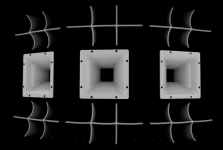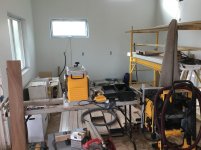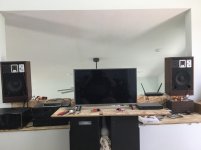Still infected with the Coax virus, I accidentally landed in the "Beyond the Ariel" thread.
In this specific part (p. 848 > ca. p. 875) many relevant and interesting topics are discussed, including notable contributions by Lynn Olson, Tom Danley, JMMLC and once again: Pano.
Thanks for that.
Many posts particularly relevant to our recent discussions. Confirming too, imho.
I had almost forgotten about two of TD's techniques that were mentioned for evaluating speakers.
Listening to speakers indoors thru headphones and a measurement mic...to reduce the brain's integration of speaker with room.
And generation loss recordings.
I've tried both of those, and especially liked the generation loss test (outdoors of course).
Gonna have to try it on latest synergy attempt, since I'm feeling it is best sound I've achieved.
Camplo,
The specs on those look quite impressive for what your after.......you going to cross around 800? Where’s the phase plugs?
Tnargs.....don’t be a hater! 😀
It is repeatable because in the beginning I lost it a couple times and managed to get it back.
Lost it due to driver changes,xo changes, then finally figured out it was phase/polar/timing related and now I can dial in and out with ease using dsp.
Still really don’t know exactly what the true workings are but definately know it is real and repeatable.
The TD18H+ can be used as a midwoofer. I wouldn't cross it above 500Hz, but 800Hz seems doable.
The sense of listening to "the real thing" is indeed related to phase, timing etc., but also to size (scale) and interaction with the room.
The great (late) Richard C. Heyser found the Klipschhorn to be capable of creating such illusions, despite its shortcomings.
Attachments
-
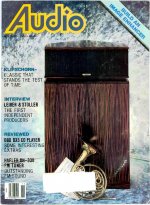 Pagina's van Audio-1986-11_Pagina_1.jpg561.6 KB · Views: 388
Pagina's van Audio-1986-11_Pagina_1.jpg561.6 KB · Views: 388 -
 Pagina's van Audio-1986-11_Pagina_7.jpg923.1 KB · Views: 146
Pagina's van Audio-1986-11_Pagina_7.jpg923.1 KB · Views: 146 -
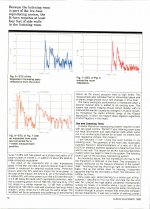 Pagina's van Audio-1986-11_Pagina_6.jpg836.1 KB · Views: 151
Pagina's van Audio-1986-11_Pagina_6.jpg836.1 KB · Views: 151 -
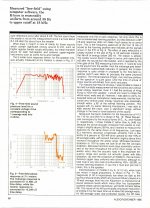 Pagina's van Audio-1986-11_Pagina_5.jpg588.7 KB · Views: 368
Pagina's van Audio-1986-11_Pagina_5.jpg588.7 KB · Views: 368 -
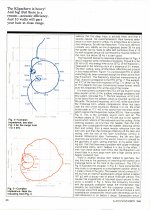 Pagina's van Audio-1986-11_Pagina_4.jpg935.9 KB · Views: 382
Pagina's van Audio-1986-11_Pagina_4.jpg935.9 KB · Views: 382 -
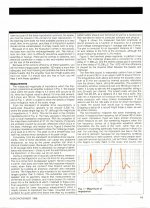 Pagina's van Audio-1986-11_Pagina_3.jpg633.7 KB · Views: 383
Pagina's van Audio-1986-11_Pagina_3.jpg633.7 KB · Views: 383 -
 Pagina's van Audio-1986-11_Pagina_2.jpg906.7 KB · Views: 395
Pagina's van Audio-1986-11_Pagina_2.jpg906.7 KB · Views: 395
Last edited:
Huh......one of my all time favorite demos was a Khorn with a crites xo
And heck if camplo is crossing that cd at 300 then I don’t see why not!
And heck if camplo is crossing that cd at 300 then I don’t see why not!
Many posts particularly relevant to our recent discussions. Confirming too, imho.
Sometimes, a little cross-referencing goes a long way 😉
Well the 10khz topic has been gone over. The axi can reach ~19-20khz, and there is no break up that I know of, its just lacking of some type of sonic quality that I am not sure exactly what, isn't to every ones liking?
I just looked at the specs of my amp compared to the lab gruppen IPD, the crowns have a higher signal to noise ratio....I got the notion off this guy who had noise floor issues Dual AE TD18H+ Mains -TD15M center by Lukeamdman but I guess I'm in the clear
Ro808 clean out your inbox.....
The idea of having the 2 woofers below the horn is in the interest of having the best woofer for midbass (td15m in this case), and separating sub bass from that, signal in order to avoid IMD due to high excursion needed to create that part of the spectrum, at significant levels. More so, I may end up crossing anywhere from 200hz to 700hz, I still have the jbl2451sl. Experimentation is needed. I'd like to think that time domain issues are more forgiving at this end of the spectrum, and crossing from woofer to woofer at ~100hz will go unnoticed with best practices in mind.
I just looked at the specs of my amp compared to the lab gruppen IPD, the crowns have a higher signal to noise ratio....I got the notion off this guy who had noise floor issues Dual AE TD18H+ Mains -TD15M center by Lukeamdman but I guess I'm in the clear
Ro808 clean out your inbox.....
The idea of having the 2 woofers below the horn is in the interest of having the best woofer for midbass (td15m in this case), and separating sub bass from that, signal in order to avoid IMD due to high excursion needed to create that part of the spectrum, at significant levels. More so, I may end up crossing anywhere from 200hz to 700hz, I still have the jbl2451sl. Experimentation is needed. I'd like to think that time domain issues are more forgiving at this end of the spectrum, and crossing from woofer to woofer at ~100hz will go unnoticed with best practices in mind.
Last edited:
The idea of having the 2 woofers below the horn is in the interest of having the best woofer for midbass (td15m in this case), and separating sub bass from that, signal in order to avoid IMD due to high excursion needed to create that part of the spectrum, at significant levels. More so, I may end up crossing anywhere from 200hz to 700hz, I still have the jbl2451sl. Experimentation is needed. I'd like to think that time domain issues are more forgiving at this end of the spectrum, and crossing from woofer to woofer at ~100hz will go unnoticed with best practices in mind.
Why not go for a smaller mid-woofer when using a sub?
Like 12PR320, low mass better RMS, better mids:
FaitalPRO | LF Loudspeakers | 12PR320
^^The reason most use subs.....
It will be just like integrating any subs except there won’t be the luxury of placement?
It will be just like integrating any subs except there won’t be the luxury of placement?
Last edited:
I don't want it any where but grouped in with the rest of the drivers.
Smaller mid-woofer, yes I've been notified of this, everyone keeps recommending 12 inchers, probably not a coincidence to that either. I still wanted a larger woofer and this one seems to be one of the best of the bigger ones.
Dual Fold On-Axis Transmission Line Enclosure Calculator - DB DYNAMIX AUDIO
1/4 Wave Flared Vent T-Line/Horn/Bass Reflex Enclosure Calculator - DB DYNAMIX AUDIO
Not sure what I think of these calculators, is there some software that will model response of a transmission line?
Smaller mid-woofer, yes I've been notified of this, everyone keeps recommending 12 inchers, probably not a coincidence to that either. I still wanted a larger woofer and this one seems to be one of the best of the bigger ones.
Dual Fold On-Axis Transmission Line Enclosure Calculator - DB DYNAMIX AUDIO
1/4 Wave Flared Vent T-Line/Horn/Bass Reflex Enclosure Calculator - DB DYNAMIX AUDIO
Not sure what I think of these calculators, is there some software that will model response of a transmission line?
It's not often you come across a PA mid-high top consisting of 2x10" + 1" (BMS) with the xo at 900Hz, all the more so as the specified max. SPL is > 140dB.
@camplo, inbox tidied up.
@camplo, inbox tidied up.
Attachments
Last edited:
Well, I will be the little girl who stands next to this parade of royalty and declares that the emperor has no clothes.
I would not like your chances of replicating these experiences of The Mystery, under controlled listening conditions.
And if you can't, then your experiences are not generated by sound waves, and the emperor will be seen by all to be naked.
cheers
Why sugarcoat it? Since you haven't directly experienced this effect - that makes us either liars or delusional. Is that it?
Well, Stereo is an illusion, however way you want to put it. If that makes me delusional, so be it! 😛
The row of names scottjoplin mentioned sure would be a good place to start:
Toole, Olive, Linkwitz, Geddes etc have done work to correlate measurements/reality to perception
Add to that list some other names like Dunlavy, Danley and Griesinger and I'm sure a couple more names should be mentioned, throw it in a blender and extract commonalities and start to find out/discover your 'own' truth from there on. That's a gross description of what I tried to do. All written down here on the forum for anyone to read/judge. Not looking to please anyone but myself but willing to share and learn from other like-minded people.
Not sure what I think of these calculators, is there some software that will model response of a transmission line?
Not sure either, so it's probably best to wait until our own TL-guru (GM) wakes up.
Last edited:
It's not often you come across a PA mid-high top consisting of 2x10" + 1" (BMS) with the xo at 900Hz, all the more so as the specified max. SPL is > 140dB.
Hi Ro, I'd dismiss that SPL claim, unless you're willing to venture into mathematical extractions that add + 6dB for very short term peaks, on top of uncompressed driver power ratings, on top of the 1 watt response curve....most likely at or near at the response curve's highest point.
Gotta love max SPL specs 😡😉
Plus, having experience with bigger brothers to the 2x10" +1" BMS, well....I call bullshite !
But Camplo, add me to the group that says go with a 12" or something smaller for mid bass. Mainly to keep C to spacing within 1/4 WL. I think doing that not only works for good acoustic summation, but also kinda self-solves the 'directionality handshake' between the horn and cone (if cone box is designed sensibly)
Here’s my fr @ lp (about 9’) avg’d entire track (one of my test tracks)
Yikes! Way more than cinema sound specs designed for max speech intelligibility.
GM
Care to elaborate on yikes! I find it quite balanced and clean......there’s peaks between 112-115db to get that 104 db avg @ lp.
It needs to be an exceptional recording to reach these levels.
Edit.....don’t be afraid to hurt my feelings, I need all the input I can get!
It needs to be an exceptional recording to reach these levels.
Edit.....don’t be afraid to hurt my feelings, I need all the input I can get!
Last edited:
I've been studying transmission lines, which I way be able to use for the 18 if the output allows.
I need to find a nice transmission line modeler. All I understand is the length and dampening.
An expanding transmission line....looks like a horn to me.
I'm trying to specifically figure out the effects how the dimensions of the the line (outside of length) affect the sound. The length is tied to tuning frequency but everything else seems to be modifiable, but I can't find material on what the results will be, other than, a line that tapers increases extension or something to that effect.
Its specs are excellent for TL. Actually, due to the 'nature of the beast', all driver specs are excellent for TL since damping ameliorates all.
Hornresp is plenty good enough, but if you can 'obtain' MJK's long since unavailable Mathcad WSs and the Win 2k Pro it was designed for, or at least ran flawlessly on mine and not so much on 7 Pro/64.........
Because it is: Resonances of open air columns
'Sounds' like you might be overthinking it a bit. A good ROT from a T/S POV is max flat vented [where Vb = Vas, Fb = Fs] = conical [untapered] TL and as Qts' goes lower the more inverse tapered it becomes and vice versa, ergo inverse tapered for this 18".
T/S of course increases tuning to maintain a flat response, so lower tunings often require unacceptably large/long vents to achieve a low vent mach, ergo think of the tapered TL as the box/vent morphing into a TL; then to the first approximation, sim a vent area [Av] = [Sd] to the desired tuning and use this total volume, [Sd] for the TL with length being the tuning variable and driver location slides up/down based on taper ratio, which all of this is 'brain dead' simple to do with HR's Wizard.
Sound wise is basically the same as comparing different well damped vented alignments, so set the desired Q like for sealed and ideally tune no lower than Fs [once damped, so will be somewhat shorter] for high power. For modest power and/or blending to room gain, tuning to actual Fs and let the desired stuffing Q 'drag' it lower.
To flatten impedance/phase, then the alignment is a conical Fs/Qts'. This is normally the largest TL since length doesn't primarily affect tuning, so expect a relatively short, very 'fat' cube to the desired ~ 4 - 10x Vas it takes, which with a ~390 L Vas, 0.22 Qts is up to a < 2 ft high stage/platform, possibly big enough for your seating area or turned on end for whatever.
With it being so large, folding it into a truncated bass horn may be a better choice, though of course the trade-off of being more 'picky' about room location.
GM
Qts' = Qts + any added series resistance [Rs]: HiFi Loudspeaker Design
edit: Ideally need MathCad 2k Pro too IIRC, though best to research this on DIYaudio and/or MJK's Facebook groups since he's removed his tech heavy yahoo group
Last edited:
The 18 will be used for a sub, phase plugs were out of stock at the moment, they will come in a separate shipment.
I've been studying transmission lines, which I way be able to use for the 18 if the output allows. I need to find a nice transmission line modeler. All I understand is the length and dampening. An expanding transmission line....looks like a horn to me. I'm trying to specifically figure out the effects how the dimensions of the the line (outside of length) affect the sound. The length is tied to tuning frequency but everything else seems to be modifiable, but I can't find material on what the results will be, other than, a line that tapers increases extension or something to that effect.
The TD18's sound excellent. If you are planning a higher order alignment such as a TL or horn variant I would highly recommend measuring your drivers. These are small batch, hand made drivers so there can be significant variation from the factory specs. It's best to use the parameters from your particular drivers to design this type of cab with.
Also the cones on these are very light which results in high efficiency and a low Qts, but they are not as strong, or stiff, as heavier, dedicated "sub" units. I would recommend being careful and conservative with the pressures on the cone when using these in any type of "loaded" bass design. If you don't plan to drive them very hard it may be a non issue. Just something to keep in mind.
Why not go for a smaller mid-woofer when using a sub?
Like 12PR320, low mass better RMS, better mids:
FaitalPRO | LF Loudspeakers | 12PR320
By all accounts, this is a fabulous sounding Mid/Bass driver and has stellar mids.
Hi Ro, I'd dismiss that SPL claim, unless you're willing to venture into mathematical extractions that add + 6dB for very short term peaks, on top of uncompressed driver power ratings, on top of the 1 watt response curve....most likely at or near at the response curve's highest point.
Gotta love max SPL specs 😡😉
Plus, having experience with bigger brothers to the 2x10" +1" BMS, well....I call bullshite !
Of course, it's marketing, or more appropriate: window dressing.
Why would someone (the designer) with >25 years experience in the PA business allow oneself to fall into this trap?
Probably, because everyone else does.
Last edited:
Care to elaborate on yikes! I find it quite balanced and clean......there’s peaks between 112-115db to get that 104 db avg @ lp.
It needs to be an exceptional recording to reach these levels.
Edit.....don’t be afraid to hurt my feelings, I need all the input I can get!
Not critiquing/criticizing your choice, just surprised by it since it's appears to be in some ways even more extreme than a small cinema's already extreme screen curve required for high speech intelligibility in a large, high human [soft] volume environment.
Not familiar with/hard to decipher such a wide band SPL chart, but the small cinema curve appears to have an audibly different response/taper [pg. 15]: https://www.smpte.org/sites/default/files/2013-03-12-Standards-Cinema_Audio-Vessa-v2.pdf
Anyway, since we probably can't do a mostly direct comparison even if yours is a huge room filled with several hundred of your closest friends 😉, was hoping you'd provide a 2 or at least 3 dB scaled response and enough room/system details that made you arrive at it, especially since any of the SMPTE curves are very rare in a HIFI/HT app.
GM
I don’t want to muck up camplo’s thread but when I get closer to finishing my current entertainment center build I’m going to document it in a new thread.
Those measurements were in my temp/test setup in the loft which I had to recently dismantle to finish that room.....so system is boxed up at the moment for awhile to be reborn here.
New setup will have fresh 10”mtm (cinema 10’s) over 15” bass modules (lab 15’s)
Those measurements were in my temp/test setup in the loft which I had to recently dismantle to finish that room.....so system is boxed up at the moment for awhile to be reborn here.
New setup will have fresh 10”mtm (cinema 10’s) over 15” bass modules (lab 15’s)
Attachments
Last edited:
- Home
- Loudspeakers
- Multi-Way
- Is it possible to cover the whole spectrum, high SPL, low distortion with a 2-way?
